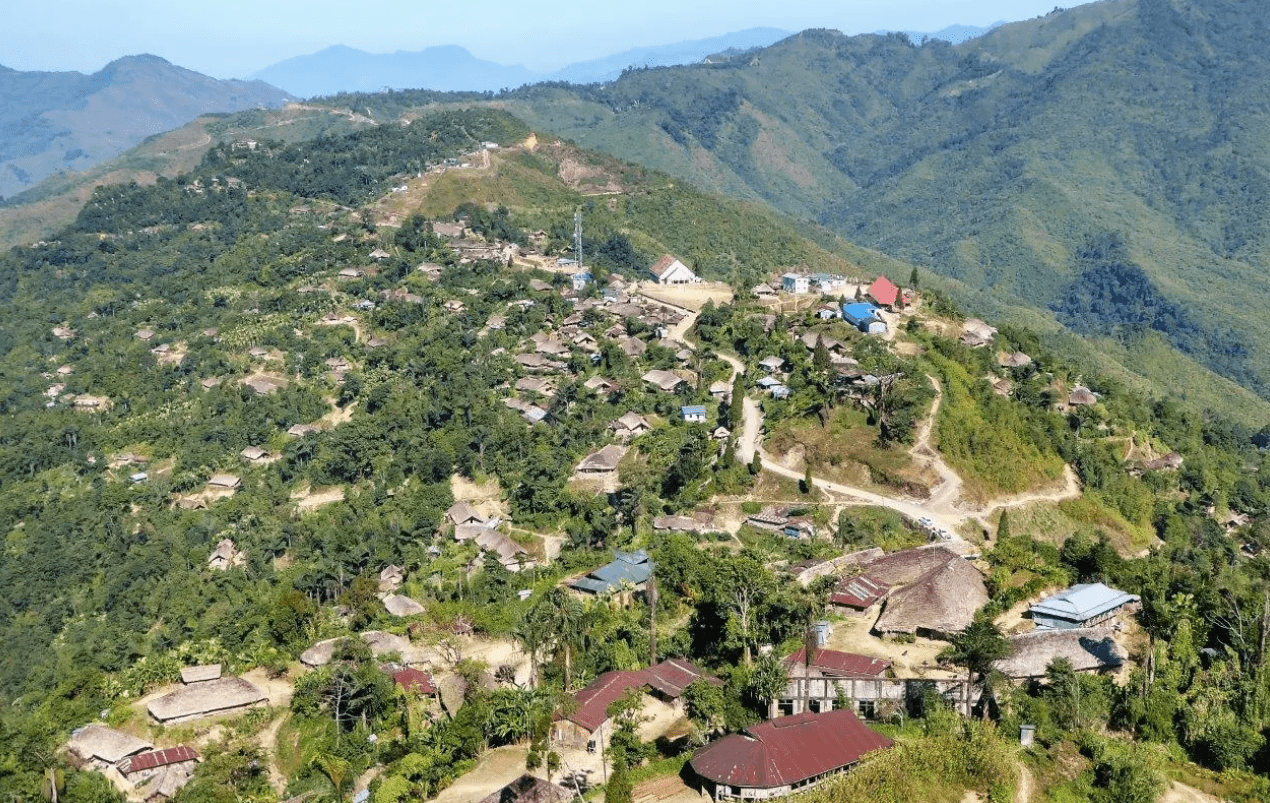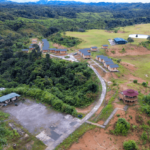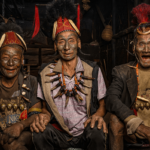The air was filled with the constant crackle of gunfire, and the pungent odor of gunpowder hung heavily around us. A haze of dust and gray enveloped the area where the shots had been fired. We found ourselves in Longwa, Nagaland—renowned for its legendary headhunting community. Despite its fierce reputation, there was no cause for concern. We were actually witnessing the vibrant Aoling Festival celebrations. The gunfire was part of the traditional festivities, with locals using their handcrafted guns in the celebrations.
Hills of Longwa, Nagaland
Longwa, situated on the Indo-Myanmar border, is a place brimming with unique characteristics. This quaint village in Nagaland is home to the last remaining tattooed headhunters of the Konyak tribe, who possess dual citizenship with both India and Myanmar. These intriguing aspects, among others, have long made Longwa a highly anticipated destination for us.
Longwa – The Realm of the Formidable Konyak Nagas
Nagaland is steeped in rich folklore and traditions passed through generations. While the landscape captivates with its wild beauty, the region also enchants with its cultural tales. The Konyak tribe, a significant part of Nagaland’s heritage, is famous for their headhunting practices and facial tattoos. Once fierce warriors, the Konyaks earned infamy for their practice of beheading enemies and displaying their heads as trophies. By the 1970s, headhunting and tattooing were outlawed in Nagaland.
Tattooed Headhunters of Nagaland, India
For more information about Nagaland’s headhunters, you can read our dedicated blog on the topic.
Longwa was once a prominent village in the Konyak region. Its proximity to the Indo-Myanmar border fostered strong ties with Myanmar, and it is home to a few remaining tattooed headhunters, making it a fascinating place to explore.
Longwa – A Place Where Opium Meets Daily Rituals
In Longwa, opium is prevalent yet strictly prohibited—a notable paradox. The British introduced opium alongside Christianity, education, and modernization to the Konyak tribe to temper their aggression. While it did reduce the tribe’s fierceness, it also led to widespread addiction, affecting family dynamics and leading to women working in the fields. The ongoing availability of opium from Myanmar exacerbates the issue. Despite its illegality in India, it is common to see Longwa’s men using opium.
Longwa and Christianity
Despite the opium haze, Longwa’s residents are devout Christians. They diligently attend church, play Christian music, and adhere to their religious practices.
The arrival of Christianity brought modern amenities such as schools and medical facilities. Although the Konyaks adapted to modern ways, they lost many of their traditional practices.
Before Christianity, inter-village relations were tense, with many villages considering each other as enemies. Christianity introduced the concept of neighborly love, allowing free movement and friendships between villages.
Nagaland, predominantly Christian, observes a near-total closure on Sundays, affecting shops, restaurants, and transport—something we learned the hard way in Mizoram, so we planned accordingly.
Trip to Longwa
After a pleasant stay at Sheanghah Chingyu, another Mon district village, we embarked on our journey to Longwa. The drive was rugged, winding through green mountains and bamboo groves. We passed areas marked by jhoom cultivation and saw woodcutters’ huts.
Arriving at Longa after a bumpy ride, we navigated through the village and reached the Baptist Church, where the Aoling Festival was being celebrated. We stayed at Longwa Tourist Guest House, conveniently located across from the Angh’s residence.
Longwa – A Unique Border Village
Longwa’s uniqueness lies in its location along the Indo-Burmese border, with its inhabitants holding dual citizenship. This border facilitates free trade and movement, evident in the presence of Burmese bikes throughout Longwa.
The border runs through the village, though the actual line with the army post is slightly beyond it, leading to an intriguing local phenomenon.
A House Across Two Nations
A saying goes, “The King of Longwa eats in India and sleeps in Myanmar.” According to historical borders, the Indo-Burmese border once cut through the Angh’s house, straddling India and Myanmar. A sign marks this geographical quirk.
We visited this house in the afternoon, as it was directly opposite our guesthouse. The Angh’s residence is a grand Konyak-style home. Our host promised a tour of the Angh’s house the following morning.
Things to Do in Longwa
To clarify, Mon district has both a Mon town and Mon village. Confusing, right?
Longwa, one of Mon district’s largest and most tourist-friendly villages, offers a deeper insight into Konyak life. Here are some activities to consider:
- Visit the Angh of Longwa
The Angh, a prominent Konyak chief, governs 30 villages in Myanmar and 11 in India, including Longwa. His calm demeanor belies his authority over 41 villages across both nations.
Following our host’s promise, we visited the Angh’s house after breakfast. The traditional Konyak longhouse is adorned with artifacts, guns, and animal skulls. The border between India and Myanmar runs through this house.
- Photograph the Border Pillar
Just outside Longwa, the viewpoint offers expansive views of Nagaland and Myanmar. A border pillar, inscribed with India on one side and Myanmar on the other, marks the line between the two countries.
- Visit the Gunmakers of Longwa
Each Konyak household has a gun, a legacy of headhunting days. The gunmaker in Longwa, though on holiday for the Aoling Festival, has an open workshop where visitors can see his creations.
- Meet the Metalsmiths and Artists
Konyaks are skilled in wood carving and metalwork. We explored a metalsmith’s workshop filled with intricate statues and handicrafts, showcasing the tribe’s artistry.
- Explore Longwa on Foot
Walking around Longwa is the best way to experience the village. Although a guide can help with language barriers, strolling through the village allows for meaningful interactions and discoveries, like the tree where headhunters once displayed their trophies.
- Visit the Morungs
Morungs are traditional dormitories for young Konyak men. Visiting them offers insights into the community’s way of life, with drums used for communication during various events.
- Watch the Sunset at Zero Point
The Zero Point, near the India-Myanmar border and an army camp, provides a serene sunset view.
- Meet the Last Tattooed Headhunters
Interact with surviving tattooed headhunters in Longwa, though a guide is recommended. Their traditional attire and tribal jewelry are fascinating.
How to Reach Longwa
To reach Longwa, first get to Mon. The journey involves navigating rough roads, with the nearest airport at Dibrugarh, Assam. Shared vehicles and cabs are available, but be prepared for multiple changes and potentially bumpy rides.
Where to Stay in Longwa
We stayed at Longwa Tourist Guest House, conveniently located across from the Angh’s house. Basic yet clean, it offers good food. Another option is Jeilei’ Homestay.
Best Time to Visit Longwa
October to April is ideal, avoiding the monsoon season’s heavy rains and poor road conditions. For festival experiences, plan to visit during the Aoling Festival from April 1 to 6.
Permits for Visiting Longwa
Indian tourists need an Inner Line Permit (ILP), easily obtainable online for INR 50. Foreign tourists must register with the Foreigner’s Registration Officer within 24 hours of arrival.
Additional Tips
- An ILP is required for Indian tourists.
- Hiring a guide can enrich your experience.
- The Nagamese language is commonly spoken.
- Respect local customs and be prepared to offer some money for photographs of headhunters.
- Be mindful of the army presence due to the border location.


